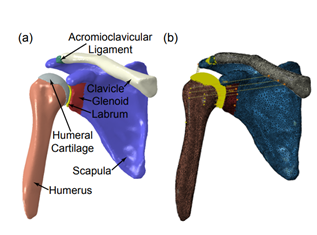Catalog of Regulatory Science Tools to Help Assess New Medical Devices
This regulatory science tool presents a computer model of a male human shoulder that simulates the abduction of the shoulder joint in the scapular plane.
Technical Description
This tool comprises a finite element model of a male human shoulder joint. The model is provided in Abaqus file format. Geometry was obtained from NIH's National Library of Medicine Visible Human Project and includes the humerus, scapula, clavicle, humeral cartilage, glenoid cartilage, labrum, and acromioclavicular ligament. Musculature was simulated with two-dimensional connector elements for the supraspinatus, infraspinatus, subscapularis, teres minor, mid-deltoid, and clavicular head of the pectoralis major. Material properties were obtained from literature. The model simulates raising the upper arm, specifically humeral abduction of the shoulder joint in the scapular plane. Simulation outputs include contact forces and stresses.

(a) Model geometry and (b) corresponding finite element model.
Intended Purpose
The male human shoulder finite element model simulates abduction of the shoulder joint in the scapular plane. The main output of the model is glenohumeral contact force. However, other outputs such as stress, strain, contact area, and contact pressure can also be extracted from the model.
This open-source model serves as an accessible foundation for future development and in silico testing of shoulder medical devices such as total shoulder arthroplasty implants. The finite element model, with additional verification and validation activities, may be used to supplement traditional preclinical mechanical performance testing.
Testing
The model simulates humeral abduction. This simulation consists of two dynamic, explicit steps. In the first step, a compressive displacement boundary condition brings the humeral and glenoid cartilages in contact. In the second step, 100о of abduction rotation is applied to the humerus. Muscle forces are applied in the second step with amplitudes taken from the literature. Model results were validated against literature values of in vivo experiments and other simulations of humeral abduction. The model outputs glenohumeral contact force in addition to generating other quantities of interest such as stress, strain, contact area, and contact pressure.
The model underwent a mesh convergence study to demonstrate quantities of interest were not dependent on mesh discretization.
Simulations were conducted on several computer systems to ensure outputs were not influenced by hardware or software installations.
Limitations
The model is limited in several ways:
- It is only validated for one humeral abduction scenario. Additionally, the validation comparator is limited to literature data.
- Mesh independence is only valid for the current geometry and loading scenario.
- The geometry is limited to a single human male subject.
- Muscles are simulated using two-dimensional elements, preventing muscle stress prediction.
- Boundary/loading conditions are rigidly prescribed and may not fully capture subtleties of shoulder motion.
Supporting Documentation
The Abaqus model (.cae and .jnl) and all supporting documentation (.docx) may be downloaded from GitHub – Shoulder Finite Element ModelExternal Link Disclaimer
A corresponding publication describing the model in greater detail is available from Annals of Biomedical Engineering: A Validated Open-Source Shoulder Finite Element Model and Investigation of the Effect of Analysis Precision | SpringerLinkExternal Link Disclaimer (https://doi.org/10.1007/s10439-022-03018-8External Link Disclaimer).
Contact
Tool Reference
- In addition to citing relevant publications please reference the use of this tool using RST24OP04.01
